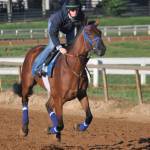Thoroughbred Joint Injuries During Training

Skeletal injuries are common when young Thoroughbred horses enter a program of race training. During the months of training leading up to, and between, actual racing starts, horses are subject to various problems related to accidental injury, overuse, fatigue, or inflammation.
The goal of this study was to find the incidence of trauma to limb joints in two-year-old Thoroughbreds in race training. Within this broad goal, smaller goals were to determine the most common types of joint problems; the specific joints affected most often; and the relationship of joint disease to particular months of the year.
Study Description
The study group was made up of 850 Polish-bred Thoroughbred horses. The group contained horses of both sexes. All horses were long yearlings (in the late fall of the year following their birth year) when the study started, and each horse was followed in the study until the late fall of its two-year-old year. At the beginning of the study, all horses were examined for general condition and the possible presence of any disease that could affect the locomotor system. No disorders affecting the leg joints were found in any of the horses.
During the study, all horses that showed lameness or other signs of pathologic change were sent to the Sluzewiec Horse Hospital where they were given an extensive orthopedic examination. In most cases, radiographs were taken to establish or confirm the clinical diagnosis. In general, contusions of the soft tissues near a joint where there was no change observed in the joint itself were classified as soft tissue injuries. In cases of injury resulting from force where the joint was damaged and there were also injuries to the adjoining cartilage and bone end plates, the injury was classified as aseptic arthritis. Injuries involving a tear or total break of the joint cavity or ligaments were classified as dislocations.
Diseases were categorized by the affected structure (muscles, tendons, ligaments, joints, bones, soft tissue, or hoof structures). Next, those problems affecting joints were classified as to type including inflammation (arthritis), stiffness or fusion (ankylosis), dislocation, and various other problems. Finally, the frequency of joint injuries was related to the month during which the injuries occurred.
Results
During the study period, the 850 horses sustained 861 injuries. This number reflects the fact that some horses were injured more than once, with just over 60% of all horses sustaining at least one injury. Among all the injuries, 232 involved muscles, ligaments, or tendons. Joint injuries were seen in 214 instances, and 176 were classified as soft tissue injuries (wounds, hematomas, or abscesses of the skin or subcutaneous tissue). There were 148 cases of bone disease, while 80 cases involved the hoof structure. In 11 horses referred for examination because of lameness or abnormal gait, either there was a diagnosis of ataxia (incoordination related to the nervous system) or no disease was found.
Categorization by type of disease showed that arthritis was the most common problem, accounting for about 84% of referrals. A similar study by Mason and Bourke found bucked shins to be the most common disease, followed by arthritis.
The fetlock was the site of the majority (almost 50%) of joint problems for horses in this study.
Other joints commonly affected, in diminishing order of frequency, were the knee (20%) and hock (16%).
The authors explained that joints closer to the body were less likely to be injured because they are typically surrounded by large muscle masses. The stabilizing effect of heavy muscling protects these joints, while joints further from the body lack the same type of support. The ligaments and joint capsule provide some stabilization, but are themselves subject to stress and injury when excessive force is applied.
A correlation was found between injuries and month of the year. The authors state, “Most injuries occurred between June and October, particularly in June, and between August and October (the beginning of racing season for two-year-old horses).” They explain further that the risk of joint injuries is increased by fatigue such as that resulting from high-speed racing.
Incidence of Injuries Among Young Thoroughbreds in Race Training
Previous studies have shown that, while some of the impact associated with rapid movement is disbursed through the bones and muscles, the majority is transmitted to the joint surfaces.
Joint inflammation is extremely common in young Thoroughbreds during the first year of race training, with fetlock joints being injured most frequently. The authors state, “The increased number of limb joint injuries between June and October (racing season for two-year-old horses) shows that the extreme exhaustion after participation in races has an essential influence on the increase in the incidence of trauma of joint injuries of two-year-old Thoroughbred horses.”
The study, “Injuries of limb joints during race training of two-year-old Thoroughbred horses,” was conducted by M Dzierzecka, A Charuta, A Wasowski, B Bartyzel, and I Janiuk, Warsaw University of Life Sciences, Poland.








